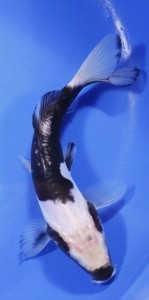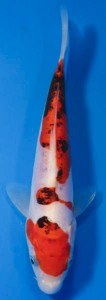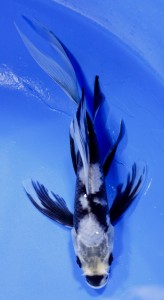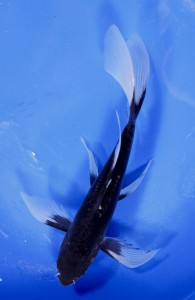Perhaps one of the most extensive classifications of koi fish (and also one of the most popular) is the Kawarimono (kah-WAH-ree-MOH-noh)—or by it’s updated name—Kawarigoi (kah-WAH-ree-goy)
As we discussed in a previous blog post, this grouping of koi fish is one that cuts a broad swath through koi classification to describe those non-metallic koi that didn’t readily fit into the other classes.
To make it a little more understandable, it is helpful to divide the classification into two groups: black and single (or solid) colored koi.
Black Koi Kawarimono
Kumonryu (KOO mahn droo)
 Perhaps the most popular of the black koi varieties, these koi are black Doitsu (scaleless) koi. The “nine crested dragon” was so named because of its similarities to ink representations of Japanese dragons. The black underlay is covered with random white markings on its head, fins and body which some describe as a “killer whale pattern.
Perhaps the most popular of the black koi varieties, these koi are black Doitsu (scaleless) koi. The “nine crested dragon” was so named because of its similarities to ink representations of Japanese dragons. The black underlay is covered with random white markings on its head, fins and body which some describe as a “killer whale pattern.
Interestingly enough, this type of koi will alter coloration throughout the course of its life, from solid white, to solid black (and almost all variations in between). It is not known what precipitates the change, however, it is believed that maturity, bloodline, pH and water temperature can all play a factor.
Although predominantly scaleless, this classification also includes single lines of sizeable lateral and dorsal mirror scales.
Click here to learn more and to check the availability of this koi fish for sale.
Beni Kumonryu (BEN-ee-koo-mahn-droo)
 Beni Kumonryu are essentially Kumonryu with red markings. Scaleless (doitsu), this koi has red added to the black and white patterns.There are those that believe this koi should reside in theHikarimoyogroup, because of the metallic patina of the black, white, and red colors.
Beni Kumonryu are essentially Kumonryu with red markings. Scaleless (doitsu), this koi has red added to the black and white patterns.There are those that believe this koi should reside in theHikarimoyogroup, because of the metallic patina of the black, white, and red colors.
Like the Kumonryu, the Beni Kumonryu will change colors during the course of its lifetime. Seasons seem to prompt the changes most noticeably. In the winter it will become completely black but as the warmer months approach the red and white will come out. Koi of this variety may also have a line of mirror scales along the lateral and dorsal lines.
For more about this breed as well as the availability of this koi fish for sale, click here.
Matsukawabakke (maht -SOO-kah-wah-BAHK-keh)

Think Kumonryu with scales. Black (sometimes appearing gray) and white, the Matsukawabakke is believed to be responsible in part for the Kumonryu’s existence after being crossbred with theShusui. Another changeling, this black and white koi will change colors numerous times in its life.
For more about the availability of this koi fish for sale, click here.
Karasu (KAH-rah-soo)

Taking it’s name from the Japanese word for “crow,” this typically fully-scaled koi will sometimes come with an almost blue tinge. Its distinguishing feature is the belly, which will come in orange, red, yellow or white.
Click here to learn more and to check the availability of this koi fish for sale.
Hajiro (hah-GEE-row)

This solid black koi is distinguishable from the Karasu by its white markings on the tail and pectoral fin tips. Another similar koi is the Hageshiro (HAH-geh-SHEE-row). Like the Hajiro, it has white-tipped fins but with the addition of white on the head.
For more about this breed as well as the availability of this koi fish for sale, click here.
In our next post we will explore the single-colored Kawarimono koi.
From Kawarimono to Utsurimono, Next Day Koi has your tastes in koi fish covered. We offer a wide selection of koi fish sourced from some of the best farms around the world to help you stock up. Coupled with a great selection of both sizes and types, we leverage our high volume of shipping through UPS to bring you some of the most competitive Next Day Air shipping rates in the industry.
Contact one of our representatives to see how we can help you stock your pond.
